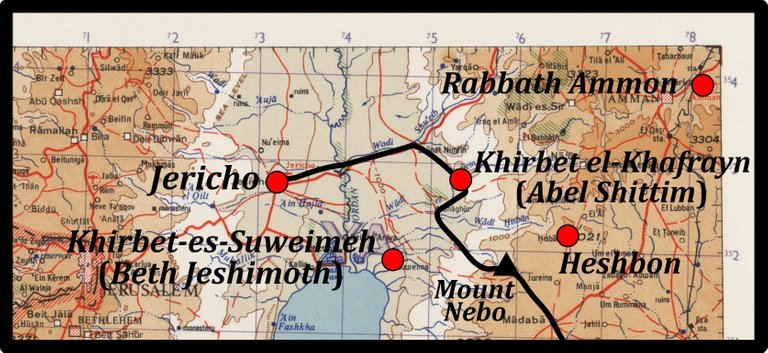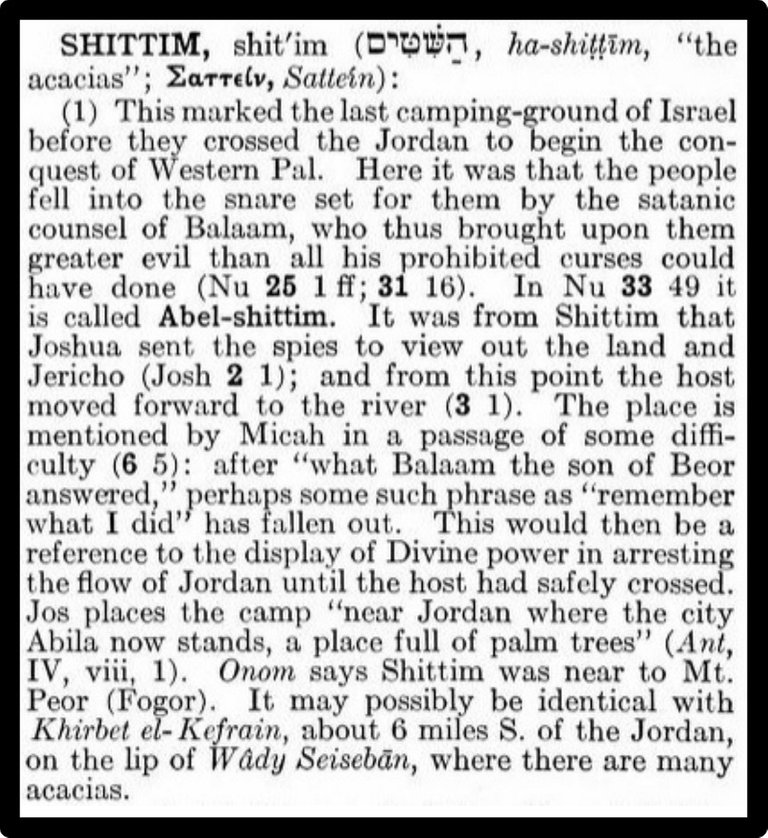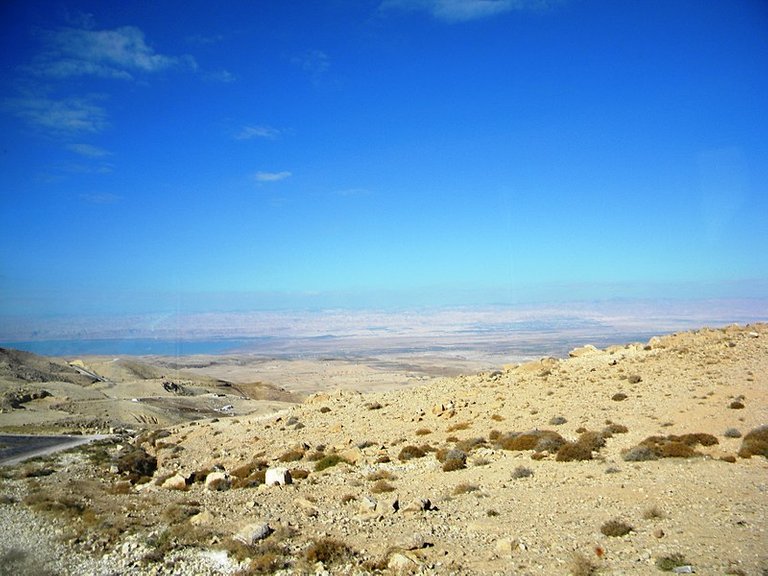
According to the Catalogue of the Stations of the Exodus in Chapter 33 of the Book of Numbers, the forty-second and last station was located in the Plains of Moab:
And they removed from Almondiblathaim, and pitched in the mountains of Abarim, before Nebo. And they departed from the mountains of Abarim, and pitched in the plains of Moab by Jordan near Jericho. And they pitched by Jordan, from Bethjesimoth even unto Abelshittim in the plains of Moab. (Numbers 33:47-49)
The main Exodus narrative in Numbers 21 and 22 uses virtually the same phrase to describe this station, though several of the details of the itinerary are different:
And from Bamoth in the valley, that is in the country of Moab, to the top of Pisgah, which looketh toward Jeshimon ... And the children of Israel set forward, and pitched in the plains of Moab on this side Jordan by Jericho. (Numbers 21:20 ... 22:01)
As we have seen, there is some overlap between these two accounts:
Pisgah and Nebo are generally considered to refer to one and the same mountain, an equation that is justified by a passage in Deuteronomy: And Moses went up from the plains of Moab unto the mountain of Nebo, to the top of Pisgah, that is over against Jericho. (Deuteronomy 34:1)
Bethjesimoth and Jeshimon may refer to one and the same place. The former has been tentatively identified with Khirbet-es-Suweimeh, which is close to the mouth of the River Jordan, near the northern shore of the Dead Sea (Orr 449, 1622).
In the preceding article, we identified the Mountains of Abarim with Mount Nebo. Unlike the majority of the Stations of the Exodus, the identity of the Plains of Moab presents us with little difficulty. The location of Jericho is undisputed, and the valley of the River Jordan has hardly shifted since the days of the Old Testament. The plains of Moab on this side Jordan by Jericho can be easily identified on a modern map of the region:

The only task that remains is to identify Bethjesimoth and Abelshittim, which represent the extreme points of the area occupied by the Israelites. We have already seen, however, that there are good candidates for these two toponyms. Bethjesimoth has been identified with Khirbet-es-Suweimeh. As for Abelshittim, in a previous article we read J Maxwell Miller’s comment on Numbers 33:45-49:
The exact names Dibon-gad, Almon-diblathaim, and Abel-shittim are also unique to this passage, but they clearly correspond to Dibon, Beth-diblathaim, and Shittim well known in other texts. (Miller 581)
Shittim, or Ha-Shittim is now widely identified with Abila in Transjordan, an ancient city about 20 km east of Jericho. Abila is identified with the modern Khirbet el-Kafrayn or the nearby archaeological site of Tell el-Hammam:


Numbers
Khirbet-es-Suweimeh and Abila lie about twelve kilometres from one another. By the time the Exodus narrative had acquired its final form, the host of Israel had swelled to a nation of over 600,000 men of military age (Numbers 1:46), implying a grand total of as many as two and a half million people (Berlin & Brettler 129). If such a huge body of people encamped in the Jordan Valley across the river from Jericho, they could very well have covered a large area—with several kilometres lying between Bethjesimoth and Abelshittim.

But in this series of articles, I have made the working assumption that the Israelites who took part in the Exodus were merely the House of Israel, comprising the descendants of Jacob’s family—which had settled in Egypt a few generations before the Exodus—together with their servants and dependents. In Part 13 of this series, I concluded:
It is conceivable that the original unadorned story of the Exodus recorded that 600 families of the House of Israel went out of Egypt. And if there were an average of ten individuals per family, then the number of Israelites at the time of the Exodus would have been approximately 6000.
6000 people would not require an area of land 12 km long for an encampment. So, where was the final Station of the Exodus?
The simplest answer can be found by regarding the references to Bethjesimoth and Abelshittim as later additions to the text. In the Catalogue of the Stations in Numbers 33, omitting verse 49 leaves us with:
And they removed from Almondiblathaim, and pitched in the mountains of Abarim, before Nebo. And they departed from the mountains of Abarim, and pitched in the plains of Moab by Jordan near Jericho. (Numbers 33:47-48)
Verse 49—And they pitched by Jordan, from Bethjesimoth even unto Abelshittim in the plains of Moab—does indeed seem to be a later addition. The unnecessary repetition of pitched by Jordan ... in the plains of Moab suggests as much. Note also that the Exodus narrative in Numbers 21-22 does not mention Bethjesimoth or Abelshittim. It simply records that the children of Israel set forward, and pitched in the plains of Moab on this side Jordan by Jericho.

The final Station of the Exodus was across the Jordan from Jericho. Abel Shittim lies in approximately the same latitude as Jericho and about 12 km from the Jordan. Perhaps this was the actual location of the final encampment. Kenneth Kitchen thinks so:
and after several stops [the Israelites] arrive by the Jordan, in the area of Abel-Shittim and the “Plains of Moab” opposite Jericho (Num. 22:1; 33:46-49). (Kitchen 194)
That this was so is supported by the fact that it was from here that Joshua is alleged to have sent out spies to reconnoitre the land:
And Joshua the son of Nun sent out of Shittim two men to spy secretly, saying, Go view the land, even Jericho. (Joshua 2:1)
Conclusion
The Forty-Second Station of the Exodus, The Plains of Moab, was located at Abel Shittim, in the vicinity of the modern Khirbet el-Khafrayn, or Tell el-Hammam.
And this is a good place to stop.
To be continued ...
References
- Adele Berlin & Marc Zvi Brettler (editors), The Jewish Study Bible, Jewish Publication Society TANAKH Translation, Oxford University Press, Oxford (1999)
- Kenneth A Kitchen, On the Reliability of the Old Testament, William B Eerdmans Publishing Company, Grand Rapids MI (2003)
- John McClintock, James Strong, Cyclopaedia of Biblical, Theological, and Ecclesiastical Literature, Volume 8, Harper & Brothers, New York (1879)
- J Maxwell Miller, The Israelite Journey through (Around) Moab and Moabite Toponymy, Journal of Biblical Literature, Volume 108, Number 4, pp 577-595, The Society of Biblical Literature, Atlanta, GA (1989)
- James Orr (General Editor), The International Standard Bible Encyclopedia, Volume 4, The Howard-Severance Company, Chicago (1915)
Image Credits
- Map of the Plains of Moab: University of Texas Libraries, Perry-Castañeda Library Map Collection, Jerusalem, D Survey, Great Britain War Office and Air Ministry (1960), Public Domain
- Tell el-Hammam: © Deg777, Creative Commons License
- The Dead Sea and the River Jordan from Mount Nebo: © Britchi Mirela], Creative Commons License

Exodus to the Red Sea- the Discoveries of Ron Wyatt